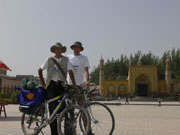All winds blow to kashgar
Preface
Chapter 1. RED MOUNTAIN
Chapter 2. VIA TIGER JAWS
Chapter 3. THE KINGDOM OF SANDS AND FOG
Chapter 4. WITH THE FAIR WIND
Chapter 5. THE ONLY AND UNIQUE KASHGAR
Chapter 6. KASHGARIAN MONDAYS
chapter 5. the only and unique kashgar
The night before arriving in Kashgar we spent not far off the town of Artush which had been playing a part of advanced post of Kashgar since olden times. Some time Shokan Valikhanov, as many travelers, also had to stay near Artush and wait for getting a permit for the caravan he passed in. And though we are not sure that it was that very Artush (there are a few settlements bearing the same name in Kashgar surroundings) we want to believe that this exact land keeps memories of our outstanding predecessor’s being there.
It is difficult to go to a place if in your thoughts you have already arrived in there. This is what we felt with Kashgar – the last 50 kilometers seemed just endless; moreover, everything grew harder due to the appearance of the contrary wind and a slight rise in the road (we needed to go through the pass between the mountains Boztag and Chontag to get from Artush to Kashgar).
However that may be, at about dinnertime on September 12, 2006 the team of Avalon Historico-Geographical Society stood in the center of Kashgar on the square in front of Idgar Mosque, retaining for the history the fact of the bicycle expedition’s ending. Behind us were some 20 days and over 1300 kilometers of the journey.
We spent about a week in Kashgar. For that time the city became almost absolutely native for us, even discarding any hint on our being thousands kilometers away from home. Besides, we underwent an interesting transformation – we did not feel ourselves strangers there. I could say, we flew into local stream of things and events and for some reason began to regard Europeans we met as tourists, nobody knows why separating us from them.
It should be noted that Kashgar unlike other cities of Xinjiang we saw before is absolutely not deprived of foreign tourists’ attention. Here you can meet anyone, people from any corner of the globe following various directions – to Tibet, Kyrgyzstan, Pakistan. Besides this situation has been observed for many centuries. The profitable location of Kashgar as a trade center was the reason of its openness for ‘Western people’ even long ago despite the intolerance of the Chinese to strangers at that time.
Thus, for example in Kashgar we got acquainted with a Belgian couple, a husband and a wife in their fifties, who surmounted the Karakorum pass on bicycles. At that time they were moving back to Gilgit by bus, having sent by post their bicycles into Belgium. In Gilgit they would take a car which they left and by which they were planning to get to the very Beijing. Later at the checking-post we met a group of Englishmen who were moving from the capital of China via Kashgar and were going to end their travel in Tashkent. We ran across a very extraordinary Japanese who, unlike his compatriots which used to have a rest during a week in a year and are ardently devoted to work, had been traveling across Eurasia for a long time, going by buses and cars passing on his way. In Kashgar we encountered guys from Poland who hitchhiked through CIS countries and China (this meeting will be described in details a bit later). And in any Internet cafe of the city you may meet a lot of people speaking different languages and e-mailing in different languages to their kiths and kins about the impressions of their being in this remarkable city.
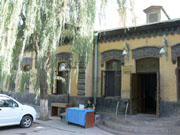 |
Former Russian consulate building
|
An interesting fact is that a place in Kashgar where foreign tourists live compactly has been for a long time Seman Hotel. It is situated in the building of the former Russian consulate – one of the centers of the so-called ‘Great Game’ for influence in Central Asia which was held between Great Britain and the Russian Empire in the late 19-th century. Actually, at present the rooms are located in several annexes, whereas the building of the consulate itself is used as a museum (rather an expensive museum it is – the admission is 15 yuans which is about 2 dollars). Despite its popularity among backpackers all over the world, Seman is not at all a cheap place, quite the contrary. Therefore, having known the prices we went out to look for a cheaper place and found it soon at a distance of 15 meters from the first Seman – Seman Road Hotel was situated across the road. The hotel was pleasantly completed by Scheherazade cafe located on the ground floor. This cafe obviously possessed a necessary balance of price and quality (we arrived at this conclusion after observing the customers of the institution, among whom were local people, Asian tourists and even those from Seman across the road). Besides its profitable position at the crossroads of Central Asia, Kashgar is interesting in itself, just as a very ancient city of the Silk Road with 2-thousand-year history. Valikhanov wrote that the trade road from Fergana Valley to Kashgar via Terekty Pass had been known even to Ptolemy. The city certainly could not have lost material evidence of its venerable age.
The central part of Kashgar is occupied by the Old City. It is really the old city, without a hint on just lay-out, with narrow and crooked streets, numerous squares used as bazaars, brick or clay houses and dark no-one-knows-where leading alleys. Idgar Mosque (its Chinese name Id-Kah) is the heart of the Old City. Built in 1442, it is the biggest mosque in China. But you should not try to see something huge and high because the size of the mosque (at least by appearance) does not strike greatly; moreover they did not use to build mosques with minarets in Xinjiang. They say, though, that it possesses startling capacity and can seat about 10 thousand people.
The evidence of old Kashgar’s existing can also be found in remains of an ancient loam wall once surrounding the city, which has been preserved somewhere in the center. Its height is about 9 meters according to our observations. Some time it was possible to enter the city from either of the two gates, the River and the Sand Gates (Suv-darvasa and Kum-darvasa correspondingly), the memory of which is kept at present only in the names of the streets.
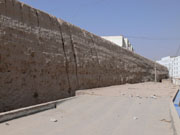 |
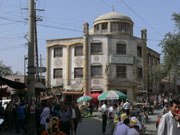 |
Remains of fortifications |
|
For centuries the essence of Kashgar has been considered to be the same: existing at the crossroads of civilizations and absorbing their various influences, the city from the very day of its foundation represented a huge bazaar where one could buy, sell or exchange everything he wished. Indeed, almost all suitable space – from narrow streets and squares of the Old City to modern many-storied trade centers – is occupied for trade. Here one can buy everything, or almost everything. This ‘almost’ concerns (however strange it may seem) not Xinjiang but Chinese goods which will be problematical (if not impossible) to find at markets and shops of Kashgar. Thus, for example, you will never find a sex-shop there, even considering all the love of the Chinese of such kind of things. Muslim culture makes certain limitations and the Chinese must try their best to overcome them.
Surely, to say that Kashgar is represented only by the entire Old City touched by antiquity would mean to sin against the truth. There are quiet contemporary buildings made of glass and concrete and usual unnoticeable blocks in the streets, which can be met in any Soviet city, as well as the monuments visible from afar which were also typical for USSR cities.
The monument to Mao Zedong is unanimously considered somewhat odd for Kashgar. I do not want to use some bawdy expressions about foreign bodies on one’s forehead, but that obviously was such kind of thing. The high granite monument representing the leader putting his hand towards radiant future, a red star on his forehead, is in a way dissonant from the surrounding realities against the background of women in veils and men in tyubeteikas, mosques and bazaars.
Pioneers met in the streets remind, though, that even in the Muslim Kashgar grandfather Lenin’s ideas are still applicable. True, the attitude of the children to the neckties usually leaves much to be desired: the ties are often shabby and ragged; they can dangle along the children’s backs and be dirty and creased. On the whole, the rule ‘once you have bound your tie, take care of it’ is absolutely not observed there. They obviously lack moral substance there.
Besides the old city (which usually stands for Kashgar itself) there is new city - Yangishar or Shule for Chinese, founded in 1838. Shule is situated 10 km southeastwards of Kashgar. This town built up by three-four-storied buildings does not represent any interest for visitors, and we had a chance to be satisfied that was true.
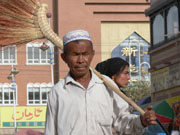 |
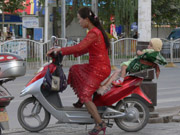 |
Sweeper |
Solution of traffic problem
|
The history of Kashgar has always been connected mostly with the Turkic peoples, and even now the Uighurs constitute over 80 percent in the city’s population. Thus, it is not surprising that the city does not look like Chinese and resembles rather a locality in the Middle East, abundant in small crooked streets, mosques and bazaars. When we conceived a desire, or even necessity to find a Chinese cafe, we faced a real problem because it turned out not so easy to find a district densely inhabited by the Chinese. In Kashgar it is easier to forget the Chinese name for the city, Kashi, which is used at the rest territory of China and even in Xinjiang more often than the Turkic one. Kashgar is a Muslim city by 99 percent, and this can explain everything. There is no other place in China where you would meet so many women who have brown veils all over their face or headscarves tied up tightly round their heads, with a narrow cut for the eyes. And even if such lady has sunglasses on her eyes and she is driving a car or a motorbike, the traditions will still remain the same.
As for other nations whose presence catches the eye, we should first mention the Pakistanis, and not without a reason, because here begins the famous Karakorum highway. It connects China with Pakistan and India and goes through the pass of the same name – one of the most popular routes in Asia among the Western people. Even on our way to
Kashgar we were asked a lot whether we were moving to Pakistan; then, in the place we could observe lots of tourists whose aim was to cross the Karakorum Pass from one of its sides. People in so-called ‘peshavarkas’ (still do not know the proper name for this Pakistani headgear) and flying clothes constitute the main part of the newcomers, who permanently inhabit the city of Kashgar, though.
‘Speaking about Kashgar, one cannot but mention Kashgarian women who were famous all around the Middle Asia’, wrote Valikhanov, adding that ‘Kashgarian water possesses a magic property to arouse love’. Actually, you may notice very quickly that the women in Kashgar are much more attractive than in other cities and towns of Xinjiang. This concerns both Chinese and Uighur women. Another ‘pearl’ that Sanya spoke out after my stories about the past of Kashgar, combined with his own observations of the female citizens, could illustrate the situation well: ‘Debauchery of previous generations had a positive influence on the local genepool’. We arrived in Kashgar on Tuesday and spent there six more days, because the tickets for the bus to Bishkek were available only for the next Monday. We had enough time to travel the length and breadth of the city. The main occupation in which we were engaged during those days was gluttony, and the scale of our engagement was enormous. We even deduced our own comic currency for measuring the price of whatever we would buy. The point is that the most optimal food for us was manty (Uighur dumplings) which cost half-yuan each there. So, a cup for 30 yuans would cost 60 dumplings for us, a bicycle-pump – 38, whereas the value of bus-tickets to Bishkek would let us buy the wagon of that tasteful stuff.
|
